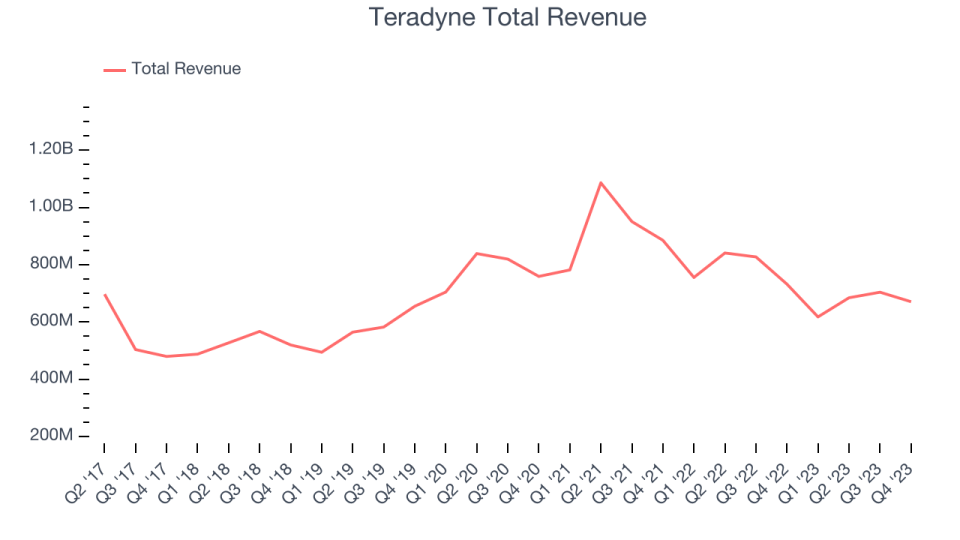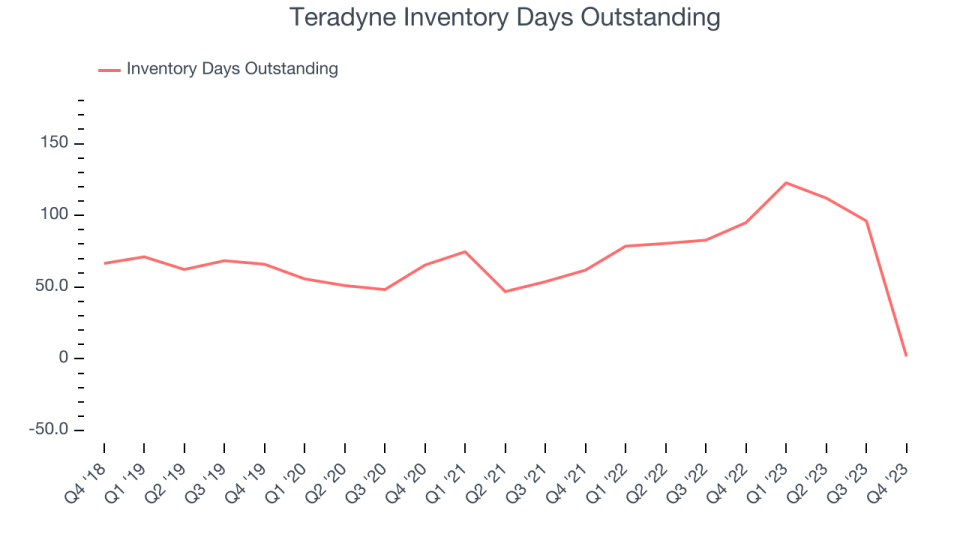Teradyne (NASDAQ:TER) Misses Q4 Analysts' Revenue Estimates, Stock Drops

Semiconductor testing company Teradyne (NASDAQ:TER) missed analysts' expectations in Q4 FY2023, with revenue down 8.4% year on year to $670.6 million. Next quarter's revenue guidance of $565 million also underwhelmed, coming in 9.6% below analysts' estimates. It made a non-GAAP profit of $0.79 per share, down from its profit of $0.92 per share in the same quarter last year.
Is now the time to buy Teradyne? Find out by accessing our full research report, it's free.
Teradyne (TER) Q4 FY2023 Highlights:
Market Capitalization: $16.22 billion
Revenue: $670.6 million vs analyst estimates of $677 million (0.9% miss)
EPS (non-GAAP): $0.79 vs analyst estimates of $0.72 (10% beat)
Revenue Guidance for Q1 2024 is $565 million at the midpoint, well below analyst estimates of $624.7 million (EPS guidance also well below)
Free Cash Flow of $204.4 million, up 46.3% from the previous quarter
Inventory Days Outstanding: 2, down from 96 in the previous quarter
Gross Margin (GAAP): 56.6%, down from 57.5% in the same quarter last year
"We closed out 2023 with Q4 revenue and profit in line with our guidance as strong demand for memory test systems and 50% quarterly growth of Robotics revenue offset weakening demand for System-on-a-Chip (SOC) test systems," said Teradyne CEO Greg Smith.
Sporting most major chip manufacturers as its customers, Teradyne (NASDAQ:TER) is a US-based supplier of automated test equipment for semiconductors as well as other technologies and devices.
Semiconductor Manufacturing
The semiconductor industry is driven by demand for advanced electronic products like smartphones, PCs, servers, and data storage. The need for technologies like artificial intelligence, 5G networks, and smart cars is also creating the next wave of growth for the industry. Keeping up with this dynamism requires new tools that can design, fabricate, and test chips at ever smaller sizes and more complex architectures, creating a dire need for semiconductor capital manufacturing equipment.
Sales Growth
Teradyne's revenue has been declining over the last three years, dropping by 3.6% on average per year. This quarter, its revenue declined from $731.8 million in the same quarter last year to $670.6 million. Semiconductors are a cyclical industry, and long-term investors should be prepared for periods of high growth followed by periods of revenue contractions (which can sometimes offer opportune times to buy).

Teradyne had a difficult quarter as revenue dropped 8.4% year on year, missing analysts' estimates by 0.9%. This could mean that the current downcycle is deepening.
Teradyne may be headed for an upturn. Although the company is guiding for a year-on-year revenue decline of 8.5% next quarter, analysts are expecting revenue to grow 11.1% over the next 12 months.
Unless you’ve been living under a rock, it should be obvious by now that generative AI is going to have a huge impact on how large corporations do business. While Nvidia and AMD are trading close to all-time highs, we prefer a lesser-known (but still profitable) semiconductor stock benefitting from the rise of AI. Click here to access our free report on our favorite semiconductor growth story.
Product Demand & Outstanding Inventory
Days Inventory Outstanding (DIO) is an important metric for chipmakers, as it reflects a business' capital intensity and the cyclical nature of semiconductor supply and demand. In a tight supply environment, inventories tend to be stable, allowing chipmakers to exert pricing power. Steadily increasing DIO can be a warning sign that demand is weak, and if inventories continue to rise, the company may have to downsize production.

This quarter, Teradyne's DIO came in at 2, which is 68 days below its five-year average. At the moment, these numbers show no indication of an excessive inventory buildup.
Key Takeaways from Teradyne's Q4 Results
We were impressed by Teradyne's strong improvement in inventory levels. We were also excited its EPS outperformed Wall Street's estimates. However, revenue missed. Also, the company's revenue and EPS guidance for next quarter both missed analysts' expectations by a large amount. Management explained this, saying "Looking into the new year, we expect low tester utilization will impact demand in the first half of the year." Overall, this was a mixed quarter for Teradyne with guidance that was particularly bad. The company is down 6.7% on the results and currently trades at $97.5 per share.
Teradyne may not have had the best quarter, but does that create an opportunity to invest right now? When making that decision, it's important to consider its valuation, business qualities, as well as what has happened in the latest quarter. We cover that in our actionable full research report which you can read here, it's free.
One way to find opportunities in the market is to watch for generational shifts in the economy. Almost every company is slowly finding itself becoming a technology company and facing cybersecurity risks and as a result, the demand for cloud-native cybersecurity is skyrocketing. This company is leading a massive technological shift in the industry and with revenue growth of 50% year on year and best-in-class SaaS metrics it should definitely be on your radar.
